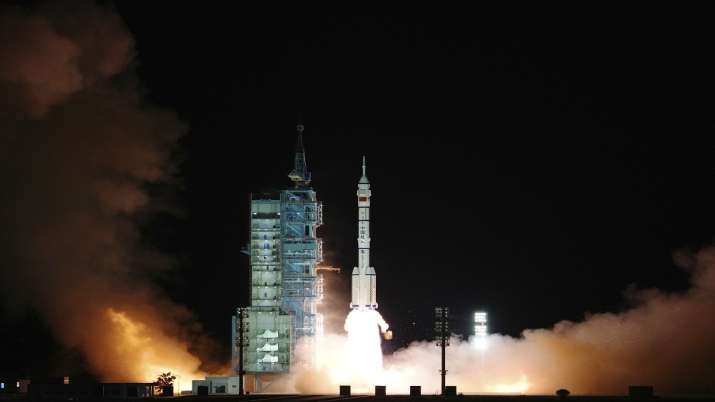
In this photo released by Xinhua News Agency, the Shenzhou-13 crewed spacecraft atop a Long March-2F carrier rocket is launched from the Jiuquan Satellite Launch Center in northwest China’s Gobi Desert.
China on Saturday launched a three-person crew for a six-month mission to its space station, which plans to set a new record for the time spent in space by Chinese astronauts, as the country completes the orbiting structure. moves towards.
The Shenzhou-13 spacecraft carrying three astronauts was launched by a Long March-2F rocket at 12:25 a.m. Saturday (4225 GMT Friday).
It is expected to complete docking with the Tianhe module within the next six hours, the start of the mission that will continue the work of the earlier three-man crew, which had spent 90 days. Those crew members performed two spacewalks and deployed a 10-metre (33-foot) mechanical arm before returning to Earth in mid-September.
The new crew includes two veterans of space travel. Pilots Zhai Zhigang, 55, and Wang Yaping, 41, the only woman on the mission, and Ye Guangfu, 41, who is making their first trip to space.
The crew was seen by a military band and supporters singing “Ode to the Motherland,” underscoring the weight of the national pride invested in China’s space program that has grown rapidly in recent years.
The crew’s scheduled activities include three spacewalks to install equipment in preparation for the expansion of the station, assess the living conditions in the module, and conduct experiments in space medicine and other areas.
China’s military-run space program plans to send multiple crews over the next two years to make the station fully functional. Shenzhou-13 is the structure’s fifth mission, which involves voyages without a crew to deliver supplies.
When completed with the addition of two more modules – named Mengtian and Ventian – the station will weigh about 66 tons, a fraction of the size of the International Space Station, which launched its first module in 1998 and will The weight will be around 450 tons.
Two additional Chinese modules are due to be launched before the end of next year during the not-yet-designated Shenzhou-14 crew stay.
China’s foreign ministry on Friday reiterated its commitment to cooperate with other countries in the peaceful use of space.
Spokesman Zhao Lijian said sending humans into space was the “common cause of mankind”, and that China would “continue to expand the depth and breadth of international cooperation and exchanges” in crewed spacecraft and “discover the mystery”. Will make a positive contribution to the “universe.”
China was kept out of the International Space Station due to the secret nature of the Chinese program and US objections to the close military ties, prompting it to launch two experimental modules before launching on the permanent station.
US law requires congressional approval for liaison between the US and Chinese space programs, but China is collaborating with space experts from countries including France, Sweden, Russia and Italy. Chinese officials have said they look forward to hosting astronauts from other countries once the space station is fully functional.
China has launched seven crewed missions with a total of 14 astronauts since 2003, when it became the third country after the former Soviet Union and the United States to put a man into space on its own. Two Chinese astronauts have flown twice.
With its crewed missions, China has expanded its work on lunar and Mars exploration, including placing a rover on the little-explored far side of the Moon and bringing lunar rocks to Earth for the first time since the 1970s. return is included.
China also landed its Tianwen-1 space probe on Mars this year, whose Jurong rover is searching for evidence of life on the Red Planet.
Other Chinese space programs call for collecting soil from an asteroid and bringing back additional lunar samples. China has also expressed aspirations to land people on the moon and possibly build a scientific base there, although no timeline has been proposed for such projects. A highly secretive space plane is also reportedly under development.
Read also | NASA’s first mission to distant asteroids is set for launch on October 16
.